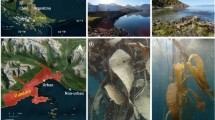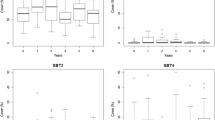Abstract
The kelp Laminaria hyperborea is regularly harvested along the Norwegian coast. Kelp trawling is regulated by restricting this to every 5th year in specified areas. The kelp plants form dense forests, 1–2 m high, and house a large number of epiphytes and associated invertebrates. Kelp, epiphytes, and holdfast (hapteron) fauna were sampled at two different regions in untrawled kelp forest and at sites trawled different number of years ago. We have examined the rate of kelp regrowth after trawling, and in what time scale the associated flora and fauna colonize the trawled areas. The trawl removed all adult kelp plants (the canopy plants), while small understorey kelp plants were left undisturbed. These recruits, given improved light conditions, made the new generation of canopy-forming kelp plants, exceeding a height of 1 m within 2–3 y. The recruitment pattern of the kelp ensures maintenance of kelp forest dominance despite repeated trawling. Both percent cover, abundance and number of epiphytic species increased with time post trawling, but epiphytic communities were not totally re-established before the next trawling episode. Colonization of most species of fauna inhabiting the kelp holdfast were found as early as one year after trawling, but increasing size of the habitat by age of kelp gave room for increasing numbers of both individuals and species. Slow colonization rate by some species might be due to low dispersal potential. Due to a higher maximum age and size of kelp plants in the northernmost region studied, restoration of both kelp and kelp forest community was slower there.
Access this chapter
Tax calculation will be finalised at checkout
Purchases are for personal use only
Preview
Unable to display preview. Download preview PDF.
Similar content being viewed by others
References
Christie, H., 1995. Description of the kelp forest fauna at Froan, Mid Norway; variation in an exposure gradient. NINA Oppdragsmelding 368: 1–22. (in Norwegian with English summary).
Connell, J. H., W. P. Sousa, 1983. On the evidence needed to judge ecological stability or persistence. Am. Nat. 121: 789–824.
Dayton, P. K., V. Currie, T. Gerrodette, B. D. Keller, R. Rosenthal, D. Ven Tresca, 1984. Patch dynamics and stability of some California kelp communities. Ecol. Monogr. 54: 253–289.
Dayton, P. K., M. J. Tegner, P. E. Parnell, P. B. Edwards, 1992. Temporal and spatial patterns of disturbance and recovery in a kelp forest community. Ecol. Monogr. 62: 421–445.
Dean, R. L., J. H. Connell, 1987. Marine invertebrates in an algal succession. I. Variations in abundance and diversity with succession. J. exp. mar. Biol. Ecol. 109: 195–215.
Fredriksen, S., K. Sjotun, T. E. Lein, J. Rueness 1995. Spore dispersal in Laminaria hyperborea (Laminariales, Phaeophyceae). Sarsia 80: 47–54.
Harkin, E., 1981. Fluctuations in epiphyte biomass following Laminaria hyperborea canopy removal. In T. Levring (ed.), Proc. Xth Int. Seaweed Symp. Göteborg, Sweden. Walter de Gruyter, Berlin and New York: 303–308.
Jones, D. J., 1971. Ecological studies on macroinvertebrate populations associated with polluted kelp forest in the North Sea. Helgoländer wiss. Meeresunters. 22: 417–441.
Kain, J. M., 1963. Aspects of the biology of Laminaria hyperborea. II. Age, weight and lenght. J. mar. biol. Ass. U.K. 43: 129–151.
Kain, J. M., 1971a. The biology of Laminaria hyperborea. VI. Some Norwegian populations. J. mar. biol. Ass. U.K. 51: 387–408.
Kain, J. M., 1971b. Synopsis of biological data on Laminaria hyperborea. FAO Fisheries Synopsis No. 87: 1–69.
Leinaas, H. P., H. Christie, 1996. Effects of removing sea urchins (Strongylocentrotus droebachiensis): Stability of the barren state and succession of kelp forest recovery in the east Atlantic. Oecologia 105: 524–536.
Lessios, H. A., J. R. Weinberg, V. R. Starczak, 1994. Temporal variation in populations of the marine isopod Excirolana: How stable are gene frequencies and morphology? Evolution 48: 594–563.
Mann, K. H., 1982. Ecology of coastal waters. A system approach. Studies in ecology Vol. 8. Blackwell scientific publications, 322 pp.
Moore, P. G., 1973. The fauna of Northeast Brittain. I. Introduction and physical environment. J. exp. mar. Biol. Ecol. 13: 97–125.
Moore, P. G., 1986. Levels of heterogeneity and the amphipod fauna of kelp holdfasts. In P. G. Moore R. Seed (eds), Ecology of Rocky Coasts, Hodder Stoughton, London: 274–289.
Norton, T. A., K. Hiscock, J. A. Kitching, 1977. The ecology of Lough Ine. XX. The Laminaria forest at Carrigathorna. J. Ecol. 65: 919–941.
Odum, E. P., 1969. The strategy of ecosystem development. Science 164: 262–270.
Oshurkov, V. V., E. A. Ivanjushina, 1993. Effect of experimental harvesting on kelp regrowth and on the structure of the shallow-water communities of Bering Island (Commander Islands). Asian Mar. Biol. 10: 95–108.
Reed, D. C., M. S. Foster, 1984. The effects of canopy shading on algal recruitment and growth in a giant kelp forest. Ecology 65: 937–948.
Rinde, E., H. Christie, S. Fredriksen, A. Sivertsen, 1992. Qko1ogiske konsekvenser av taretrâling: Betydning av tareskogens struktur for forekomst av hapterfauna, bunnfauna og epifytter. NINA Oppdragsmelding 127: 1–37. (in Norwegian with English summary).
Roughgarden, J., S. D. Gaines, S. W. Pacala, 1987. Supply side ecology, the role of physical transport processes. In J. H. R. Gee, P. S. Giller (eds), Organization of Communities: Past and Present. Blackwell Scientific Publications: 491–518.
Roy, N., H. Christie, S. Fredriksen, H. P. Leinaas, S. H. Lorentsen, 1990. Biologiske forundersokelser i forbindelse med planer om taretrâling i Sor-Trondelag. NINA Oppdragsmelding 52: 1–20. (in Norwegian with English summary).
Schultze, K., K. Janke, A. Krüss, W. Weidemann, 1990. The macrofauna and macroflora associated with Laminaria digitata and L. hyperborea at the island of Helgoland (German Bight, North Sea). Helgoländer Meeresunters. 44: 39–51.
Sivertsen, K., 1991. Hosting av stortare og gjenvekst av tare etter taretrâling ved Smola, More-og Romsdal. Fisken og Havet 1: 1–44. (in Norwegian with English summary).
Sjotun, K., S. Fredriksen, T. E. Lein, J. Rueness, K. Sivertsen, 1993. Population studies of Laminaria hyperborea from its northern range of distribution in Norway. Hydrobiologia 260 /261: 215–221.
Sjotun, K., S. Fredriksen, J. Rueness, T. E. Lein, 1995. Ecological studies of the kelp Laminaria hyperborea (Gunnerus) Foslie in Norway. In H. R. Skjoldal, C. Hopkins, K. E. Erikstad, H. P. Leinaas (eds), Ecology of Fjords and Coastal Waters. Elsevies science B.V.: 525–536.
Svendsen, R, 1972. Noen observasjoner over taretrâling og gjenvekst av stortare, Laminaria hyperborea. Fiskets Gang 22: 448–460. (in Norwegian with English summary).
Sortie, A. C. 1994. Epifyttiske alger pä hapterer og stipes av Laminaria hyperborea (Gunn.) Foslie fra Vega i Nordland fylke. (Epiphytic algae on holdfasts and stipes of Laminaria hyperborea (Gunn.) Foslie from Vega, Nordland County.) Cand. scient. thesis, University of Oslo, 110 pp.
Whittick, A. 1983. Spatial and temporal distribution of dominant epiphytes on the stipe of Laminaria hyperborea (Gunn.) Fosl. (Phaeophyta: Laminariales) in S. E. Scotland. J. exp. mar. Biol. Ecol. 73: 1–10.
Author information
Authors and Affiliations
Editor information
Rights and permissions
Copyright information
© 1998 Springer Science+Business Media Dordrecht
About this paper
Cite this paper
Christie, H., Fredriksen, S., Rinde, E. (1998). Regrowth of kelp and colonization of epiphyte and fauna community after kelp trawling at the coast of Norway. In: Baden, S., Phil, L., Rosenberg, R., Strömberg, JO., Svane, I., Tiselius, P. (eds) Recruitment, Colonization and Physical-Chemical Forcing in Marine Biological Systems. Developments in Hydrobiology, vol 132. Springer, Dordrecht. https://doi.org/10.1007/978-94-017-2864-5_4
Download citation
DOI: https://doi.org/10.1007/978-94-017-2864-5_4
Publisher Name: Springer, Dordrecht
Print ISBN: 978-90-481-5109-7
Online ISBN: 978-94-017-2864-5
eBook Packages: Springer Book Archive




